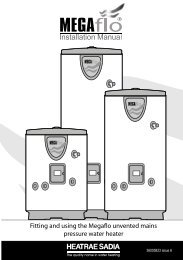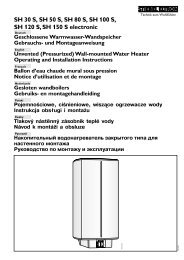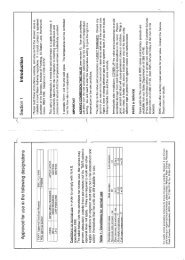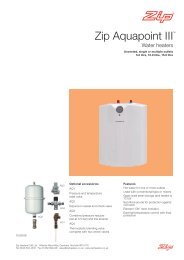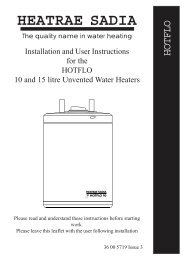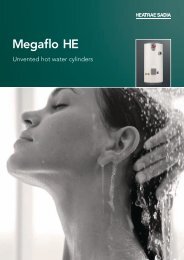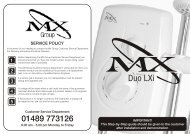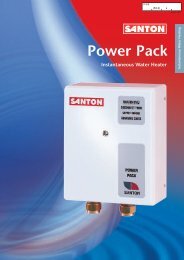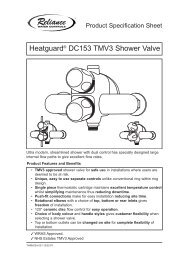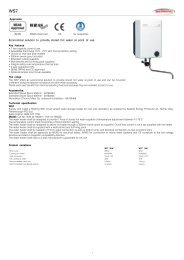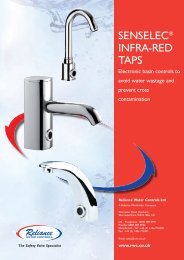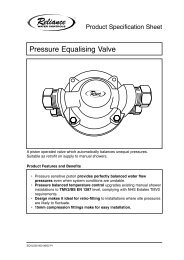Santon Premier Plus Installation Guide - Advanced Water
Santon Premier Plus Installation Guide - Advanced Water
Santon Premier Plus Installation Guide - Advanced Water
Create successful ePaper yourself
Turn your PDF publications into a flip-book with our unique Google optimized e-Paper software.
12<br />
7.0 MAINTENANCE<br />
7.1 MAINTENANCE REQUIREMENTS<br />
Unvented hot water systems have a continuing maintenance<br />
requirement in order to ensure safe working<br />
and optimum performance. It is essential that the<br />
Relief Valve(s) are periodically inspected and manually<br />
opened to ensure no blockage has occurred in<br />
the valves or discharge pipework. Similarly cleaning<br />
of the strainer element and replacement of the air in<br />
the Expansion Vessel will help to prevent possible<br />
operational faults.<br />
The maintenance checks described below should be<br />
performed by a competent installer on a regular basis,<br />
e.g. annually to coincide with boiler maintenance.<br />
7.2 SAFETY VALVE OPERATION<br />
Manually operate the Temperature/Pressure Relief<br />
Valve for a few seconds. Check water is discharged<br />
and that it flows freely through the tundish and<br />
discharge pipework. Check valve reseats correctly<br />
when released. NOTE: <strong>Water</strong> discharged may be<br />
very hot!<br />
Repeat the above procedure for the Expansion Valve.<br />
7.3 STRAINER<br />
Turn off the cold water supply, boiler and immersion<br />
heaters. The lowest hot water tap should then<br />
be opened to de-pressurise the system. Remove the<br />
Pressure Reducing Valve housing by unscrewing the<br />
four securing screws with the Allen key supplied.<br />
Pull the Reducing Valve cartridge from the Check<br />
Valve housing to access the strainer mesh. Wash any<br />
particulate matter from the strainer under clean water.<br />
Re-assemble ensuring the seal is correctly fitted, DO<br />
NOT use any other type of sealant. Ensure the four<br />
securing screws are tightened equally.<br />
7.4 DESCALING IMMERSION HEATER(S)<br />
Before removing the immersion heater(s) the unit<br />
must be drained. Ensure the water and electrical<br />
supply and boiler are OFF before draining. Attach<br />
a hosepipe to the drain cock having sufficient length<br />
to take water to a suitable discharge point below the<br />
level of the unit. Open a hot tap close to the unit and<br />
open drain cock to drain unit.<br />
Direct models:<br />
Open the cover(s) to the immersion heater housing(s)<br />
and disconnect wiring from the thermostat mounted on<br />
top of the immersion heater(s). Remove the thermostat<br />
by carefully pulling outwards from the immersion<br />
heater. Unscrew immersion heater backnut(s) and remove<br />
immersion heater from the unit. A key spanner is<br />
supplied with the <strong>Premier</strong> <strong>Plus</strong> unit for easy removal/<br />
tightening of the immersion heater(s). Over time the<br />
immersion heater gasket may become stuck to the<br />
mating surface. To break the seal insert a round bladed<br />
screwdriver into one of the pockets on the immersion<br />
heater and gently lever up and down.<br />
Indirect models:<br />
Open the cover(s) to the immersion heater housing(s)<br />
and disconnect wiring from immersion heater(s). Remove<br />
thermostat capillary sensors from the pockets<br />
on the immersion heater. Unscrew immersion heater<br />
backnut(s) and remove immersion heater from the<br />
unit. A key spanner is supplied with the <strong>Premier</strong> <strong>Plus</strong><br />
unit for easy removal/tightening of the immersion<br />
heater(s). Over time the immersion heater gasket<br />
may become stuck to the mating surface. To break<br />
the seal insert a round bladed screwdriver into one of<br />
the pockets on the immersion heater and gently lever<br />
up and down.<br />
Carefully remove any scale from the surface of the<br />
element(s). DO NOT use a sharp implement as damage<br />
to the element surface could be caused. Ensure<br />
sealing surfaces are clean and seals are undamaged,<br />
if in doubt fit a new gasket.<br />
Replace immersion heater(s) ensuring the lower (right<br />
angled) element hangs vertically downwards towards<br />
the base of the unit. It may be helpful to support the<br />
immersion heater using a round bladed screwdriver<br />
inserted into one of the thermostat pockets whilst<br />
the backnut is tightened. Replace thermostat (Direct<br />
models) or thermostat capillaries into pocket (Indirect<br />
models), rewire, check, close and secure immersion<br />
heater housing cover(s).<br />
7.5 EXPANSION VESSEL CHARGE PRESSURE<br />
Remove the dust cap on top of the vessel. Check the<br />
charge pressure using a tyre pressure gauge. The pressure<br />
(with system de-pressurised) should be 3.5bar.<br />
If it is lower than the required setting it should be<br />
re-charged using a tyre pump (Schrader valve type).<br />
DO NOT OVER CHARGE. Re-check the pressure<br />
and when correct replace the dust cap.<br />
7.6 RE-COMMISSIONING<br />
Check all electrical and plumbing connections are secure.<br />
Close the drain cock. With a hot tap open, turn on<br />
the cold water supply and allow unit to refill. DO NOT<br />
switch on the immersion heater(s) or boiler until the<br />
unit is full. When water flows from the hot tap allow<br />
to flow for a short while to purge air and flush through<br />
any disturbed particles. Close hot tap and then open<br />
successive hot taps in system to purge any air.<br />
When completely full and purged check system for<br />
leaks. The heating source (immersion heater(s) or<br />
boiler) can then be switched on.<br />
7.7 BENCHMARK TM LOG BOOK<br />
On completion of any maintenance or service of the<br />
<strong>Premier</strong> <strong>Plus</strong> the Benchmark TM “<strong>Installation</strong>, Commissioning<br />
and Service Record Log Book” should be<br />
filled in to record the actions taken and the date the<br />
work was undertaken.



